Centauri Dreams
Imagining and Planning Interstellar Exploration
Stable Orbit for a Newly Discovered Companion
The Earth is followed around the Sun by several Near Earth Asteroids in what are called ‘horseshoe orbits.’ Have a look at the NASA image below showing the orbital contours of such orbits. You can see the horseshoe shape, so called because the object’s apparent direction changes as seen by a viewer on the Earth. What’s happening is that the gravitational attraction of the Earth is changing the asteroid’s elliptical orbit. Even though the asteroid always orbits the Sun in the same direction, it cycles between catching up with the Earth and falling behind. It’s the relative motion of the object with relation to both the Sun and the Earth that produces the horseshoe effect.
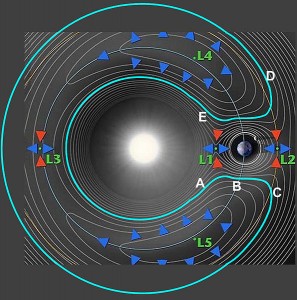
Image: Starting out at point A on the inner ring between L5 and Earth, the satellite is orbiting faster than the Earth. It’s on its way toward passing between the Earth and the Sun. But Earth’s gravity exerts an outward accelerating force, pulling the satellite into a higher orbit which – counter-intuitively – decreases its speed. When the satellite gets to point B, it is traveling at the same speed as Earth. Earth’s gravity is still accelerating the satellite along the orbital path. The satellite moves into a higher orbit. Eventually, at C, the satellite reaches a high enough, slow enough orbit and starts to fall behind Earth. It then spends the next century or more appearing to drift ‘backwards’ around the orbit. Remember that its orbit around the Sun still takes only slightly more than one Earth year and the apparent backwards motion is only relative to the Earth. Eventually the satellite comes around to point D. Earth’s gravity is now reducing the satellite’s orbital velocity, causing it to fall into a lower orbit, which actually speeds up the satellite. This continues until the satellite’s orbit is lower and faster than Earth’s orbit. It begins moving out ahead of the earth. Over the next few centuries it completes its journey back to point A. Image credit: NASA. Caption: Wikipedia.
The most recent addition to the list of objects in horseshoe orbits around the Earth is asteroid 2010 SO16, discovered by the WISE (Wide-field Infrared Survey Explorer) satellite. New work out of Armagh Observatory in Northern Ireland has now determined that, unlike other such objects, 2010 SO16 has been following the Earth on its orbit for at least 250,000 years. Other ‘horseshoe companions’ remain in this configuration for several thousand years before moving on to other orbits. Moreover, 2010 SO16 has an estimated diameter of 200-400 meters, making it easily the largest of the Earth’s horseshoe asteroids.
The object takes 175 years to travel from one end of the horseshoe to the other, in an orbit quite similar to the Earth’s. Apostolos Christou, one of the authors of the paper on this work, calls the asteroid ‘terraphobic,’ and adds “It keeps well away from the Earth. So well, in fact, that it has likely been in this orbit for several hundred thousand years, never coming closer to our planet than 50 times the distance to the Moon.” Which is, in fact, where it is right now, near the end of the horseshoe trailing the Earth.
Christou and colleague David Asher at Armagh went to work on the object’s orbital stability by creating simulations that modeled the behavior of the asteroid for every orbit it could occupy, running the simulations two million years into the past and the future. All the ‘virtual’ asteroids they plugged into this model remained in the horseshoe orbit with respect to the Earth. So 2010 SO16 has been out there for a long time. What we don’t know at this point is its origin.
Three possibilities present themselves. From the paper:
The existence of this long-lived horseshoe raises the twin questions of its origin and whether objects in similar orbits are yet to be found. The object’s Earth-like orbit makes a direct or indirect origin in the main belt an unlikely, although not impossible, proposition… Another plausible source is the Earth-Moon system. Margot & Nicholson (2003) have suggested that 54509 may have originated within the Earth-Moon system. SO16’s current orbit does not provide such a direct dynamical pathway to the Earth-Moon system as in that case, although the situation is likely to change within a timescale of several times 105 yr. A third possibility is that the object originated near the Asteroid-Earth-Sun L4 or L5 equilibrium point as a tadpole librator.
By ‘tadpole librator.’ Christou and Asher mean objects in so-called ‘tadpole orbits’ around the L4 and L5 Lagrangian points. Objects in these orbits do not move as far from the Earth as objects in horseshoe orbits. At the L4 and L5 points 60 degrees ahead of and behind the Earth in its orbit, it is possible that material left over from the formation of the inner planets may remain. Out of this population may have come the asteroids in horseshoe orbits we see today. Finding out more about such a population would require, say the authors, a space-based observatory in a heliocentric orbit inside that of the Earth, a mission we’re unlikely to see mounted any time soon.
But we can continue to study 2010 SO16 from the ground, starting with its color. Christou and Asher are quoted in this Armagh Observatory news release as saying they’re interested in the object’s color as a marker for its origin:
“Colour, a measure of an asteroid’s reflectivity across the electromagnetic spectrum, can tell you a lot about its origin,” they explain. “With this information we can start testing possible origin scenarios with hard data. If it proves to be unique in some way, it may be worth sending a probe to study it up close, and perhaps bring back a sample for laboratory scrutiny.”
The paper is Christou and Asher, “A long-lived horseshoe companion to the Earth,” in press at Monthly Notices of the Royal Astronomical Society (preprint).

Wild 2: Liquid Water Inside a Comet?
What goes on inside Kuiper Belt objects in the outer reaches of the Solar System? We can get some idea from what we’re learning about comets like Wild-2, dust grains of which were brought back to Earth in 2006 as part of the Stardust mission. The thinking about Wild-2 is that, like many comets, it originated in the Kuiper Belt out of icy debris left over from the formation of the Solar System. But its orbit was eventually disrupted by Jupiter’s gravitational influence on a pass through the inner system, sending the comet into a new, highly elliptical orbit.
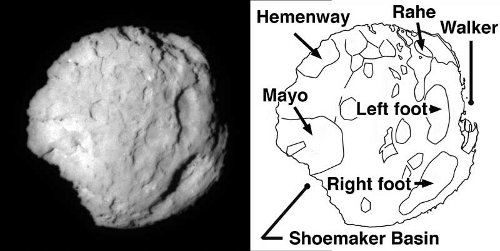
Image: Comet Wild 2, which NASA’s Stardust spacecraft flew by on Jan. 2, 2004. The picture on the left is the closest short exposure of the comet. The listed names on the right are those used by the Stardust team to identify features. “Basin” does not imply an impact origin. Credit: NASA/Stardust mission.
Now analysis of Wild-2’s dust grains is changing our view of cometary interiors. A new study by Eve Berger and Dante Lauretta (University of Arizona) points to liquid water inside the comet at some point in its history, casting doubt on the idea that cometary ice is always in a terminal state of deep freeze. Berger and Lauretta found minerals in the dust grains, minerals that form in the presence of liquid water. Lauretta, principal investigator for the study, had this to say:
“When the ice melted on Wild-2, the resulting warm water dissolved minerals that were present at the time and precipitated the iron and copper sulfide minerals we observed in our study. The sulfide minerals formed between 50 and 200 degrees Celsius (122 and 392 degrees Fahrenheit), much warmer than the sub-zero temperatures predicted for the interior of a comet.”
Lauretta is quick to note that the existing paradigm assumes liquid water cannot form inside a comet, so the finding is a surprise. The mineral in question is cubanite, a copper iron sulfide that can also be found in ore deposits on Earth that have been exposed to heated groundwater. The cubanite also gives us a read on temperatures within Wild-2, says Berger:
“The mineral we found – cubanite – is very rare in sample collections from space. It comes in two forms – the one we found only exists below 210 degrees Celsius (99 degrees Fahrenheit). This is exciting because it tells us those grains have not seen temperatures higher than that. Wherever the cubanite formed, it stayed cool. If this mineral formed on the comet, it has implications for heat sources on comets in general.”
So the evidence is that at some point, the interior of Wild-2 would have been warm enough to melt ice, but cool enough to form the detected cubanite. Two possible heat sources are available, the first being collisions with other objects, which could generate water that would allow the sulfides to form relatively quickly. The other possibility is radioactive decay which, as opposed to the collision method, would point to early formation of the minerals because the radioactive nuclides would decay over time and the heat source would be lost. In any case, we’re learning that heating and chemical reactions in liquid water can be part of a comet’s ongoing evolution.
No wonder Lauretta talks about comets ‘as individual entities with their own unique geologic history.’ Are the processes that evidently occurred within Wild-2 common to all comets? We have but one sample return mission’s results to go on, but it’s clear that getting our hands on materials from deep space objects can change the paradigm decisively. Lauretta, who is part of the development of the proposed OSIRIS-REx asteroid sample return mission, notes that flybys or remote observation cannot produce this kind of detection. OSIRIS-REx would follow the Stardust model by returning up to 2 kg of asteroid regolith to Earth, if the mission is approved.
The paper is Berger et al., “Evidence for aqueous activity on comet 81P/Wild 2 from sulfide mineral assemblages in Stardust samples and CI chondrites,” in press at Geochimica et Cosmochimica Acta (abstract). A University of Arizona news release is also available.

Impact Events Shown by Planetary Rings
Send a spacecraft into the outer Solar System and unexpected things can happen. We’re all anticipating the arrival of the New Horizons probe at Pluto/Charon in 2015, but the work the spacecraft has done along the way has recently been highlighted again. Moving toward Jupiter in 2007, New Horizons was programmed to image Jupiter’s ring system in the hope of catching details about an odd effect. Back in the 1990s, the Galileo probe had shown unusual patterns in the Jovian ring, and the New Horizons imagery was able to spot not only the patterns Galileo had seen but two new ripple patterns as well, evidence of recent events in the Jovian system.
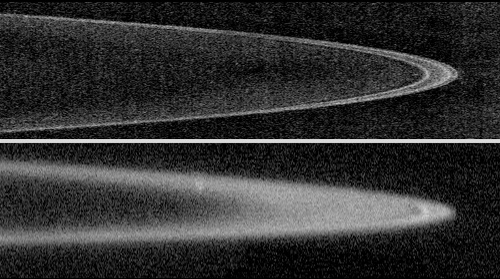
Image: The New Horizons spacecraft took the best images of Jupiter’s charcoal-black rings as it approached and then looked back at Jupiter in February 2007. The top image was taken on approach, showing three well-defined lanes of gravel- to boulder-sized material composing the bulk of the rings, as well as lesser amounts of material between the rings. New Horizons snapped the lower image after it had passed Jupiter on February 28, 2007, and looked back in a direction toward the sun. The image is sharply focused, though it appears fuzzy due to the cloud of dust-sized particles enveloping the rings. The dust is brightly illuminated in the same way the dust on a dirty windshield lights up when you drive toward a “low” sun. The narrow rings are confined in their orbits by small “shepherding” moons. Credit: New Horizons/JHU/APL.
Making sense of such patterns has involved the Cassini mission as well as New Horizons. In orbit around Saturn, Cassini has produced imagery of corrugations in Saturn’s innermost ring, called the D ring. It’s now believed, as discussed in two papers published online this week in Science, that both ring patterns are the result of an impact. In Jupiter’s case, that would be comet Shoemaker-Levy 9, which broke apart and blew through the Jovian ring system in 1994. The Saturnian ripples are likely the result of something similar, cometary debris that passed through the inner rings in 1983, although unseen by telescopes on Earth or in space at the time.
Matthew Hedman (Cornell University), Mark Showalter (SETI Institute) and colleagues studied the grooves in the D ring and determined that they appeared, over time, to wind together more tightly. Their work shows that this pattern would have originated when an event of some kind tilted the D ring off its axis by 100 meters in late 1983, with the gravity of Saturn then warping the ring into a tightening spiral. Subsequent Cassini imaging in 2009 revealed more details, and showed that the collision was huge, tilting a region more than 19,000 kilometers wide.
The scientists used the same techniques to study the pattern in Jupiter’s ring system, drawing on Galileo imagery from 1996 and 2000. Unwinding the ring pattern back in time as they did with Saturn, the duo found the event that tilted the Jovian ring off its axis would have occurred between June and September of 1994. The Shoemaker-Levy impact was in July of that year. Moreover, close study of the Galileo images has revealed a second spiral, which calculations indicate would have originated in 1990. Jupiter’s rings seem to be quite a lively place.
Add to this the fact that New Horizons has given us clues to yet another impact event, showing two new ripple patterns as well as the remaining effect from the Shoemaker-Levy impact. We begin to realize just how dynamic our Solar System remains even today, because we’re looking at a series of events that occurred within the last thirty years. Says Showalter:
“We now know that collisions into the rings are very common – a few times per decade for Jupiter and a few times per century for Saturn. Now scientists know that the rings record these impacts like grooves in a vinyl record and we can play back their history later.”
And we can tease more information out of these ring ‘signatures’ than their date of origin. Given that we’re likely dealing with a comet in each case, it’s helpful to remember how Shoemaker-Levy was pulled apart by Jupiter’s gravity before its famous collision with the planet. Causing a ring system to be knocked into a tilted orbit would not be the result of a single, solid object hitting the rings, but of an object that had been pulled apart, with a rain of small particles striking a broad ring region. We’re learning, then, about the objects moving through the outer system, and about their effect on the evolution of planetary rings, which themselves become what Joseph Burns (Cornell University) calls ‘witness plates to events in the distant past.’
The papers are Showalter et al., “The Impact of Comet Shoemaker-Levy 9 Sends Ripples Through the Rings of Jupiter,” published online in Science 31 March 2011 (abstract), and Hedman et al., “Saturn’s Curiously Corrugated C Ring,” also in Science 31 March 2011 (abstract).

At System’s Edge: The IBEX ‘Ribbon’
Studying the heliosphere and its interactions with the interstellar medium isn’t easy, which is one among many reasons we follow the fortunes of the Voyager probes with such continuing fascination. They’re pushing up against the boundary between the Sun’s local ‘bubble’ and deep space beyond, where charged particles from the solar wind are no longer a factor and the deeper rhythms of the galaxy take hold. Now our other probe of this exotic region is back in the news in a new paper. IBEX (the Interstellar Boundary Explorer) is telling us much about how our system interacts with the interstellar medium and the effects of the galactic magnetic field upon the heliosphere.
IBEX has provoked much discussion in these pages — I was amazed to see I had written fully thirteen articles on the mission in the last six years, going back to pre-launch speculations. The mission caught my eye because it was the first ever sent with the express purpose of studying the outer edges of the Solar System. The Voyagers, obviously, are powerful tools, but exploring the heliopause was not their primary mission, nor are they optimized for this kind of work. What IBEX gives us will tell us much about the strength of the interactions in the heliosheath at system’s edge.
Recall that despite its target, the IBEX spacecraft itself orbits the Earth (with an apogee of 322,000 kilometers and a perigee of 16,000 kilometers), studying the heliosphere’s boundary by examining energetic neutral particles (ENAs) that help to define it. These ENAs are swept up and scattered by the solar wind in the boundary between the edge of the heliosphere and interstellar space. IBEX has created maps based upon those ENAs that go on to pass near the Earth, telling us much about the structure of the heliosphere, and discovering that the ENA emissions do not resemble what previous models had predicted.
IBEX principal investigator David J. McComas (SwRI) commented on the most newsworthy of the IBEX results back in 2009:
“The IBEX results are truly remarkable, with emissions not resembling any of the current theories or models of this never-before-seen region. We expected to see small, gradual spatial variations at the interstellar boundary, some ten billion miles away. However, IBEX is showing us a very narrow ribbon that is two to three times brighter than anything else in the sky.”
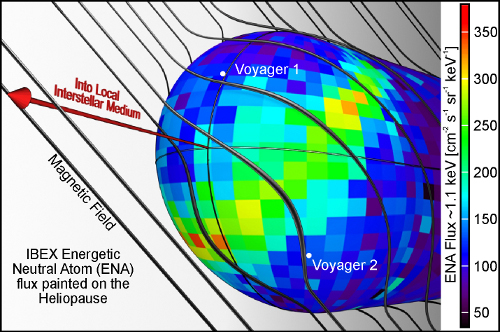
Image: This graphic illustrates one possible explanation for the bright ribbon of emission seen in the IBEX map. The galactic magnetic field shapes the heliosphere as it drapes over it. The ribbon appears to trace the area where the magnetic field is most parallel to the surface of the heliosphere (the heliopause). Credit: SwRI.
The ribbon feature was an unanticipated finding, one that required the development of a method to separate the ribbon from background emissions to obtain clearer resolution. In the new paper, Nathan Schwadron (University of New Hampshire) describes the process. Schwadron says that isolating and separating this ribbon of energy from the IBEX data was ‘like pulling the drapes from our window to discover the landscape at the edge of the solar system.’
One useful result of this work is that by learning more about the physical properties of the heliosphere, we will have a better idea how galactic cosmic rays operate both outside and inside the heliosphere, with obvious implications for planetary radiation environments not only in our system but in those around other stars. This is a murky area, and while we know that the most powerful galactic cosmic rays can penetrate the Earth’s magnetic fields and atmosphere, we have much to learn about how the heliosphere protects the Solar System from less powerful background cosmic rays.
The maps IBEX is making are probing unexplored terrain and, as the energy ribbon shows, contain surprising features.
Schwadron again:
“There are many theories about how the ribbon is created, and we don’t understand exactly what we’re seeing but it seems to be telling us something about how the local galactic magnetic field interacts with the heliosphere. This galactic magnetic field may be a missing key to understanding how the heliosphere protects the solar system from galactic cosmic rays.”
Other features of interest from the IBEX data are a ‘tail’ of emissions at the boundary — one that seems to be deflected in the direction of the galactic magnetic field — and the ‘nose’ of the heliosphere, which Schwadron likens to the “bow wave in front of a ship, which shows us how our motion through the galaxy compresses and deflects the material of the local galactic medium around our heliosphere.” But it’s worth noting that what IBEX has shown us so far differs greatly from what mission planners had expected. The crucial role of the galactic magnetic field now becomes apparent as our planetary system interacts with the galaxy.
The paper is Schwadron et al., “Separation of the Interstellar Boundary Explorer Ribbon from Globally Distributed Energetic Neutral Atom Flux,” Astrophysical Journal 731 (10 April 2011), p. 56 (abstract).

The Pioneer Anomaly Resolved?
The fascination of the so-called ‘Pioneer anomaly’ is that it offers the possibility of new physics, an apparently constant acceleration on the Pioneer 10 and 11 probes with a value of (8.74 ± 1.33) × 10?10 m/s2 being something that we can’t easily explain. Equally useful is the chance the Pioneer anomaly gives us to validate current physical models by figuring out how we might explain this acceleration through hitherto unsuspected processes, perhaps aboard the spacecraft itself. Either way you look at it, the Pioneer anomaly has deserved the attention it has received, and now a new paper emerges to take a crack at resolving the issue once and for all.
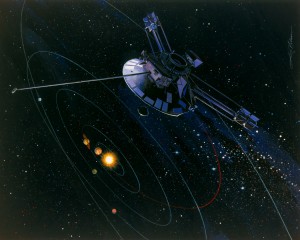
Frederico Francisco (Instituto Superior Técnico, Lisbon) and colleagues have revisited the question of whether heat that is emitted and reflected aboard the spacecraft could account for the anomalous acceleration. Francisco’s team had accounted for between 33% and 67% of the acceleration in a thermal model they developed in 2008. The new paper builds on this earlier work, with a methodology based on a distribution of point-like radiation sources that can model the thermal radiation emissions of the spacecraft. The authors then deploy a method called ‘Phong Shading’ that is commonly used to render the illumination of surfaces in 3D computer graphics. This allows them to study how heat effects can be reflected off the various parts of the spacecraft.
Image: An artist’s rendition of one of the Pioneer probes. Credit: NASA.
I referred to the acceleration as ‘apparently constant’ above, but the authors take pains to note that we haven’t fully characterized the acceleration. In fact, one analysis of the flight data shows that, given the data we have, both a constant acceleration and one with a linear decay of a period greater than fifty years are compatible with the data. This comes into play as the team tests for the constancy of the acceleration, as discussed in the paper:
… a so-called “jerk term” is found to be consistent with the expected temporal variation of a recoil force due to heat generated on board… This is essential if the hypothesis of a thermal origin for the Pioneer anomaly is to be considered, as such [a] source would inevitably lead to a decay with at least the same rate as the power available onboard. Possible causes for an enhanced decay include e.g. degradation of thermocouples, stepwise shutdown of some systems and instruments, etc.
With this in mind, the authors go to work looking at thermal radiation and the force it can bring to bear on a surface, using Phong Shading to model the reflection of this radiation off the various other surfaces of the Pioneer probes. Radiation facing outwards, for example, radiates directly into space with an effect that cancels out. But radiation emitted toward the center of the spacecraft is reflected by the high-gain antenna and the main equipment compartment. The trick is to weigh these effects in terms of the acceleration. The method gives “a simple and straightforward way of modeling the various components of reflection…,” according to the paper, and one that accounts for the effect of thermal radiation on different parts of the spacecraft.
The result: The Phong shading method confirms earlier work suggesting that the Pioneer anomaly results from heat effects aboard the spacecraft. It also offers a method with which to study similar effects aboard other spacecraft. The authors explain:
…the acceleration arising from thermal radiation effects has a similar order of magnitude to the constant anomalous acceleration reported [in a study of the anomaly published in 2002]. We believe that the chosen approach is most adequate for the study of this particular problem, taking into account all its specific characteristics. Moreover, this Phong shading method is well suited for future studies of radiation momentum transfer in other spacecraft.
And the paper concludes:
With the results presented here it becomes increasingly apparent that, unless new data arises, the puzzle of the anomalous acceleration of the Pioneer probes can finally be put to rest.
This is a useful result, and one that will now be scrutinized by the wider community. If its conclusions are accepted, we will have made a step forward in identifying an effect that may need to be taken into account in future spacecraft operations. Just as important, we’ll have been able to rule out a line of investigation that seemed to open a door into new physics, meaning that the analysis of the Pioneer Anomaly, now more than a decade old, has born fruit. This is exactly what good science should do, and while we might hope for breakthroughs into new theories, anomalies like these are just as valid as ways of testing and verifying accepted physical laws.
The paper is Francisco et al., “Modelling the reflective thermal contribution to the acceleration of the Pioneer spacecraft” (preprint).

Vesta: Closing on a Protoplanet
As the Dawn spacecraft continues on its way to Vesta, which it will reach in July, mission controllers have been putting it through its paces with a series of maneuvers that test the vehicle’s capabilities, a rehearsal for the high- and low-altitude mapping orbits it will operate in. It’s interesting to consider Dawn’s ion thrusters, which after more than 2.2 years of powered flight, continue to work flawlessly, now with a bit less than half of the original supply of xenon propellant (the spacecraft started with 425 kilograms of xenon). The velocity change in this period has been 5.7 kilometers per second, marking a record for on-board propulsion systems.
Dawn’s approach to Vesta is slow and spiraling, closing in on the asteroid at 0.7 kilometers per second as the orbital paths of target and spacecraft become more and more similar. In this mission report, chief engineer Marc Rayman (JPL) describes the trajectory, which is made possible by the high fuel efficiency of the ion propulsion system and the long periods of thrusting:
Designing the spiral trajectories is a complex and sophisticated process. It is not sufficient simply to turn the thrust on and expect to arrive at the desired destination, any more than it is sufficient to press the accelerator pedal on your car and expect to reach your goal. You have to steer carefully (and if you don’t, please don’t drive near me), and so does Dawn. As the ship revolves around Vesta in the giant asteroid’s gravitational grip, it has to change the pointing of the xenon beam constantly to stay on precisely the desired winding route to the intended science orbits.
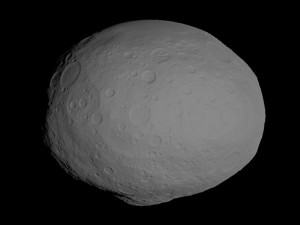
Interestingly, Rayman says that from Dawn’s perspective, Vesta is already the brightest object in the sky other than the Sun, about as bright as Jupiter appears to us in the evening skies on Earth. I keep calling Vesta an asteroid but the differences between it and other main belt asteroids are profound. Vesta is about 530 kilometers across, compared to the much smaller objects that travel with it in their orbits between Mars and Jupiter. Moreover, Vesta has undergone differentiation, meaning its structure is layered, showing a core, mantle and crust.
Image: This image shows a model of the protoplanet Vesta, using scientists’ best guess to date of what the surface of the protoplanet might look like. It was created as part of an exercise for NASA’s Dawn mission involving mission planners at NASA’s Jet Propulsion Laboratory and science team members at the Planetary Science Institute in Tuscon, Ariz. The images incorporate the best data on dimples and bulges of the protoplanet Vesta from ground-based telescopes and NASA’s Hubble Space Telescope. The cratering and small-scale surface variations are computer-generated, based on the patterns seen on the Earth’s moon, an inner solar system object with a surface appearance that may be similar to Vesta. Credit: NASA/JPL-Caltech/UCLA/PSI.
It was back in 1972 that Tom McCord (now at the Bear Fight Institute, WA) and colleagues discovered the signature of basalt on Vesta, an indicator that the object had melted at some time in the past. We now believe that Vesta had enough radioactive material inside when it coalesced that rock could melt and the lighter layers could float to the outside, a process we normally think of in planetary rather than asteroid terms. That makes Vesta interesting as a ‘protoplanet,’ a dense, layered body that never fully developed by merging with other objects of the same category.
Vesta is, in other words, a window into the remote past, one we can study by looking at the hundreds of meteorites that make up some of Vesta’s debris following ancient collisions with space rocks, and now by orbiting the distant object itself. Dawn principal investigator Christopher Russell (UCLA) describes Vesta’s significance:
“This gritty little protoplanet has survived bombardment in the asteroid belt for over 4.5 billion years, making its surface possibly the oldest planetary surface in the solar system. Studying Vesta will enable us to write a much better history of the solar system’s turbulent youth.”
We’ll have a year at Vesta to study these matters, with Dawn arriving in July at a time when the south pole will be in full sunlight and the huge crater at the pole will be completely visible. Vesta’s evolution may be put on display if we get a good enough view of the layered materials inside the crater. In any case, Dawn will be able to give us high-resolution data on the asteroid’s surface composition, topography and texture as we probe its internal and external features. More on Vesta as protoplanet in this JPL news release.


